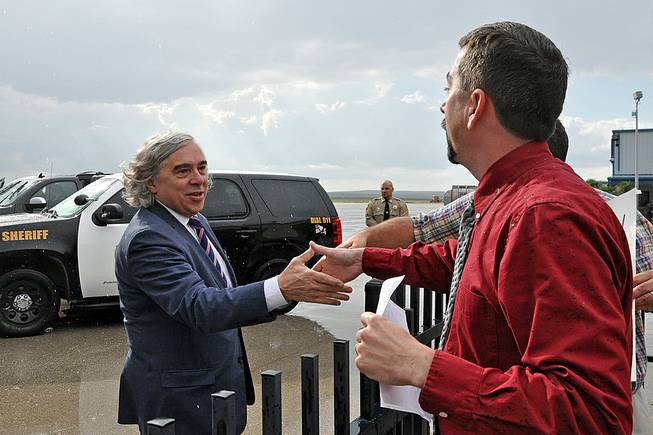
AP Photo/Carlsbad Current-Argus, Zack Ponce
Energy Secretary Ernest Moniz is welcomed at the Carlsbad, N.M., airport as he arrives in southeastern New Mexico Monday, Aug. 11, 2014, to visit the government’s troubled nuclear waste dump and talk with residents about the mysterious radiation leak and truck fire that have shuttered the Waste Isolation Pilot Plant indefinitely. About a dozen community leaders and residents were at the Carlsbad airport to welcome Moniz and show their continued support for the plant, which is the federal government’s only permanent repository for waste from decades of nuclear bomb building and employs about 650 people.
Tuesday, Aug. 12, 2014 | 12:04 a.m.
ALBUQUERQUE — Energy Secretary Ernest Moniz is vowing to get southeastern New Mexico's troubled nuclear waste dump back in operation as soon as possible after a mysterious radiation leak that has indefinitely shuttered the nation's only permanent repository for waste from decades of nuclear bomb building.
During a town hall meeting packed with state and community officials, and many supporters of the Waste Isolation Pilot Plant in Carlsbad, Moniz said, "If you stick with us, were sticking with you."
About a dozen community leaders and residents were at the Carlsbad airport to welcome Moniz and show their continued support for the plant, which employs about 650 people.
At least one speaker, however, said the leak showed the 15-year-old, multi-billion dollar project has failed and should be abandoned. Others complained about a lack of information and the slow pace of identifying the cause of the leak.
Officials have yet to pinpoint what caused a barrel of waste from Los Alamos National Laboratory to breach in one of the plant's half-mile-deep rooms Feb. 14, contaminating 22 above-ground workers with low levels of radiation. One theory has focused on a chemical reaction in highly acidic waste that was packed with organic cat litter to absorb moisture.
Moniz said the "uncertainty makes it hard for all of us," but investigators are getting closer to identifying the cause and hope to have a plan for reopening the mine in place by the end of next month.
"A plausible picture is emerging," he said. "I'm not claiming that we have everything laid out, but I think we are making great progress. Hopefully this will lead to a complete understanding in the not too distant future."
But he emphasized that safety is the priority and said "I just don't want to cut corners. ... We have to do it right."
Nine days before the release, a truck hauling salt in the mine caught fire. But officials have said the fire was far from the waste-handling area and the events were likely unrelated.
Initial investigations into both accidents have blamed a slow erosion of safety culture at the site. Officials are also investigating how Los Alamos handled the waste it sent to the plant, and whether a switch from inorganic to organic cat litter played a role in fueling a heat reaction.
During a meeting on renewable energy in Santa Fe earlier Monday, Moniz estimated it will be a year to 18 months before the plant can be reopened.
The indefinite closing of the repository has delayed cleanup of legacy waste like contaminated gloves, tools and clothing across the federal government's nuclear complex.
Los Alamos, for example, was under orders from the state to remove thousands of barrels of toxic waste from outdoor storage on a mesa before wildfire season peaked this summer. The presence of that waste, and its potential dangers, came to light three summers ago as a massive wildfire lapped at the edge of lab property.
Associated Press writer Susan Montoya in Santa Fe, New Mexico, contributed to this report.

Join the Discussion:
Check this out for a full explanation of our conversion to the LiveFyre commenting system and instructions on how to sign up for an account.
Full comments policy